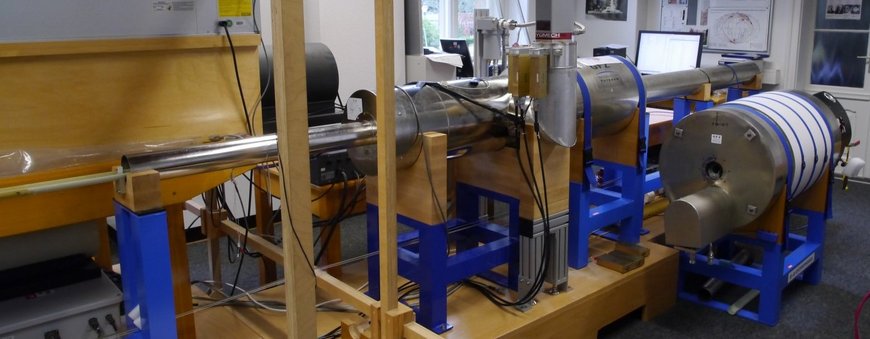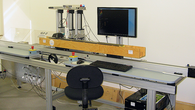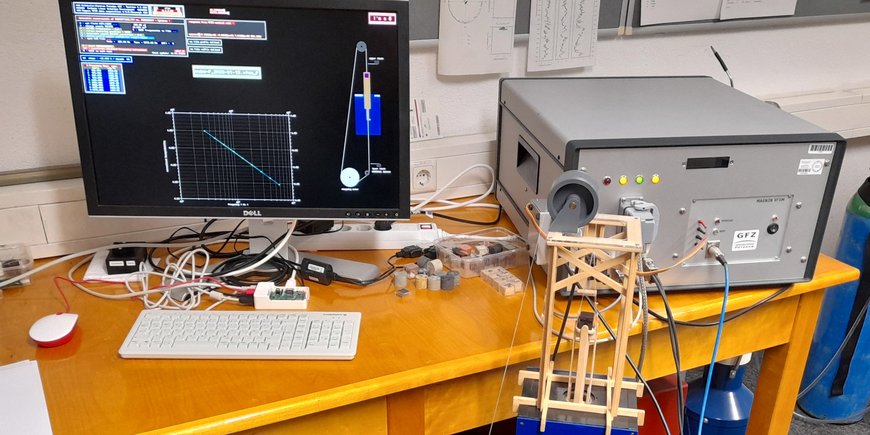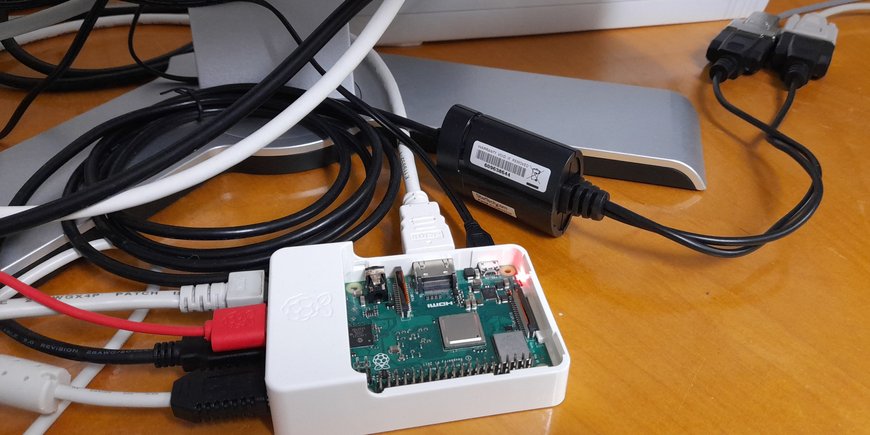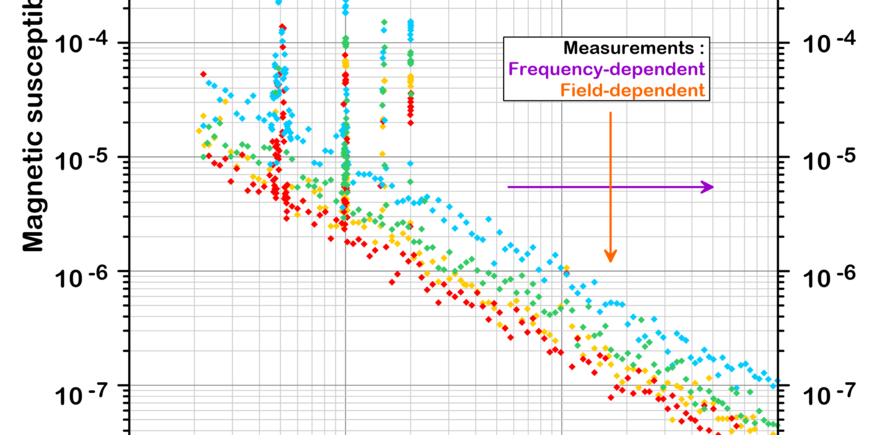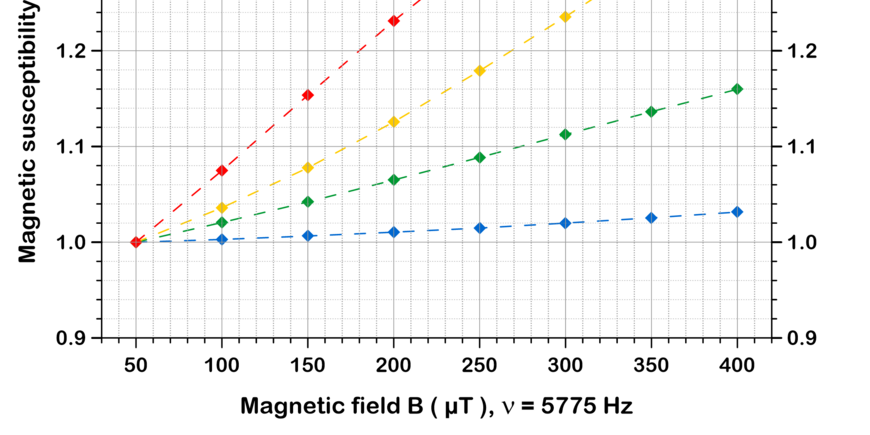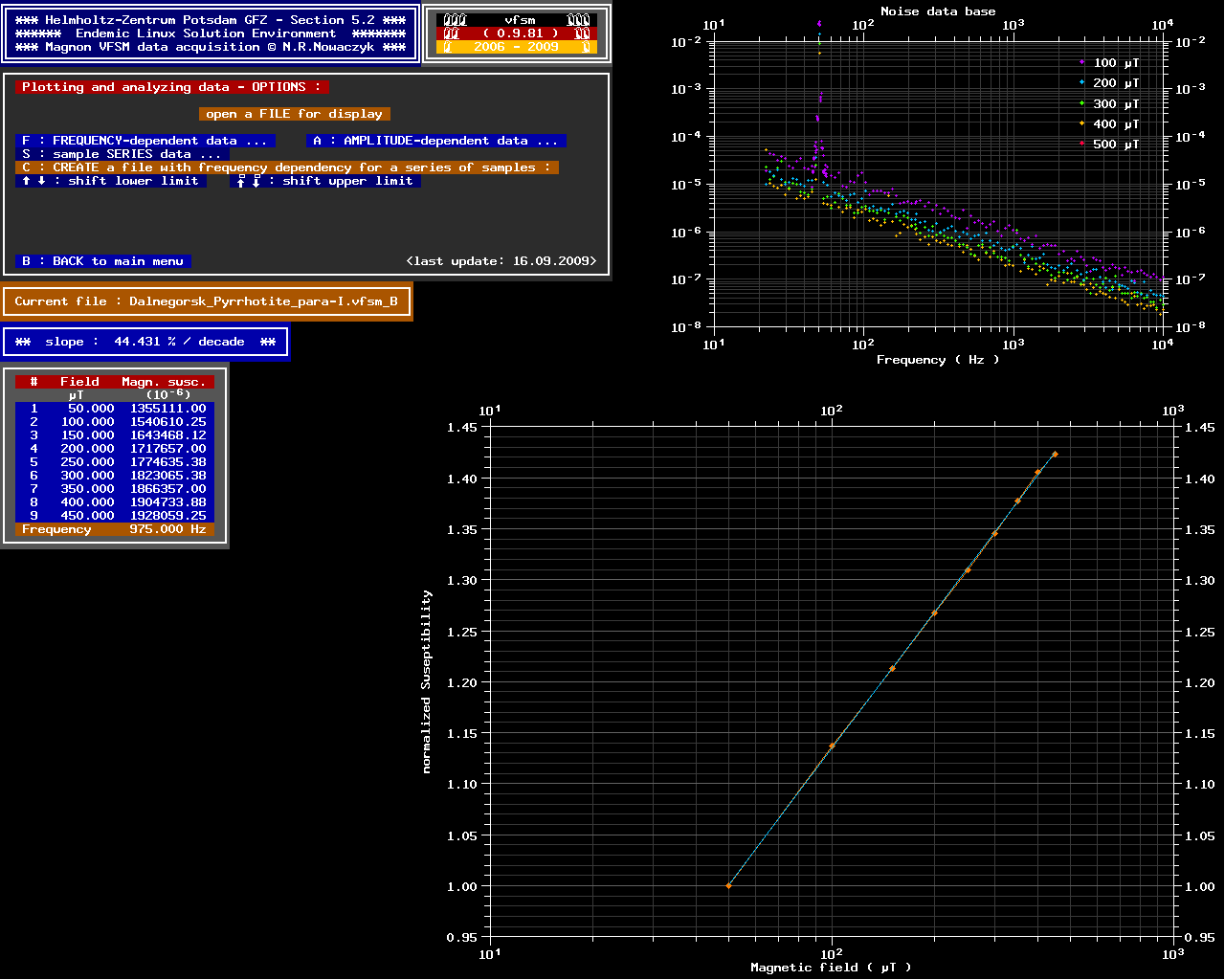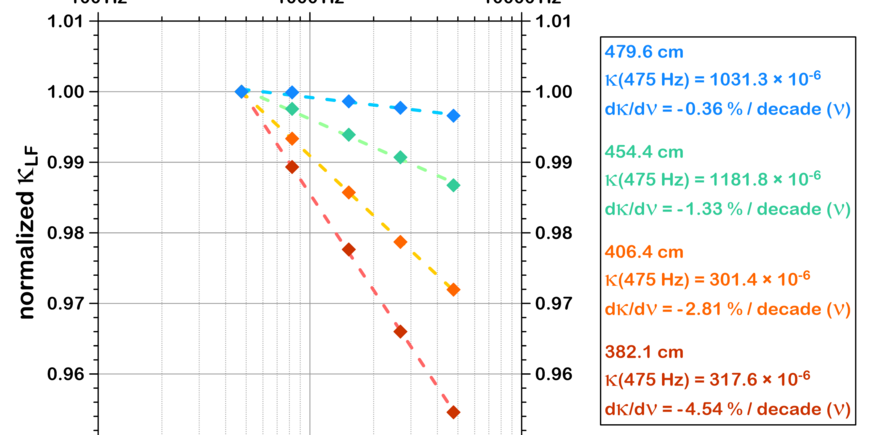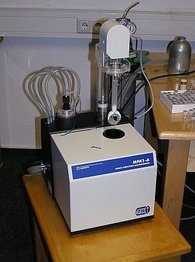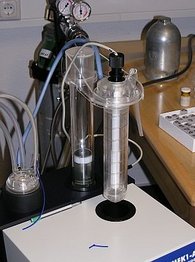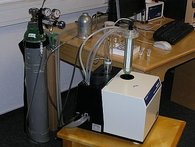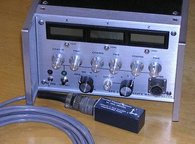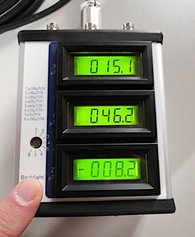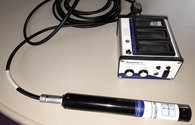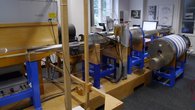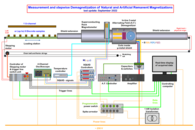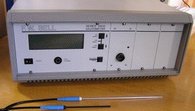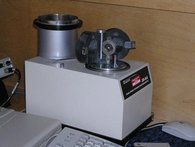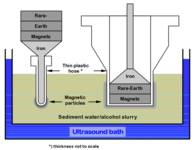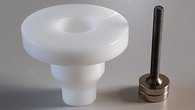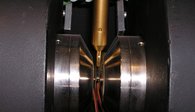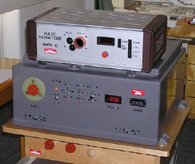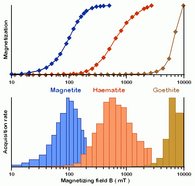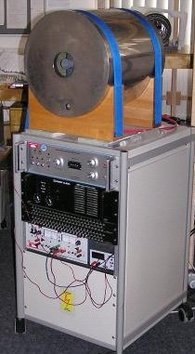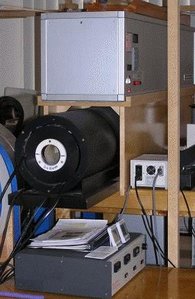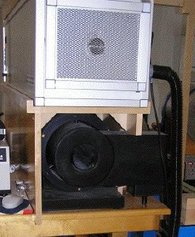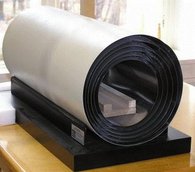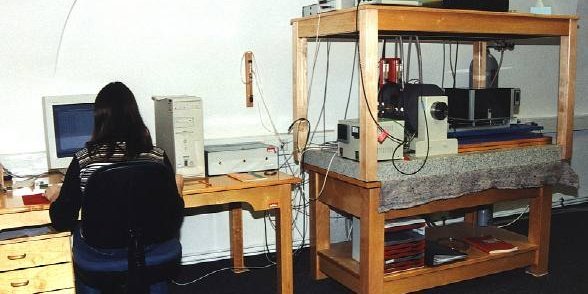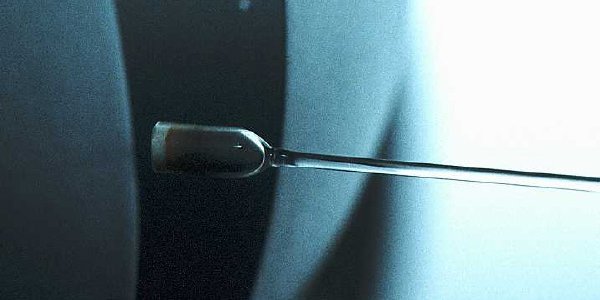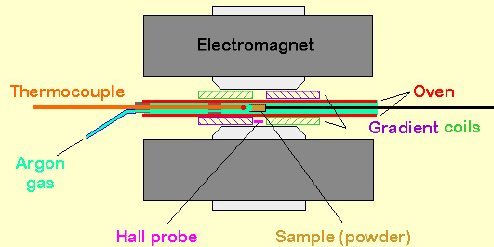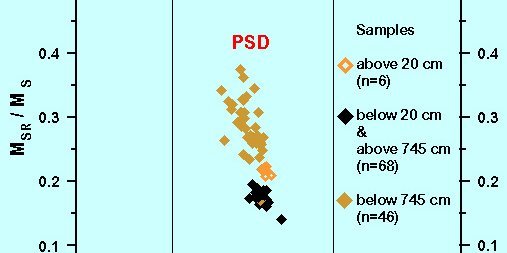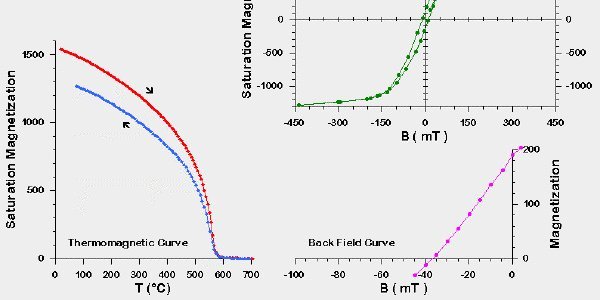- Determination of intensity and directions of sedimentary magnetizations
- Characterization of magnetic minerals by their physical properties, such as coercivity, Curie-temperature, grain size, and concentration, as well as by their chemical composition and preservation status
Analytical performance:
Fully automatic acquisition of:
- split surface morphology using a simple microswitch
- magnetic susceptibility logs of (soft) sediment cores of up to 1.5 m length using a Bartington MS2E sensor.
- the optical spectrum of sediment cores using a GretagMacbeth Spectrolino. Color measurements are performed through a circular window of 4 mm diameter. Results are given as 36 spectral lines every 10 nm from 380 to 730 nm along a single trace. Together with spectral data, XYZ and L*a*b* values are stored to an ascii file (currently unavailable).
- Measuring increment: 1 mm (or larger)
Technical concept:
- N. R. Nowaczyk, M. Voigt
Software development:
- linux software (Kubuntu Linux) for data acquisition: D. Ulbricht
Applications:
- Magnetostratigraphic investigation of lake and marine sediments.
Sample types:
- split cores, u-channels, x-ray samples.
Download:
Software:
- Linux software by N.R.Nowaczyk.
Analytical performance:
- Measurement of magnetic susceptibility of discrete samples versus field and/or frequency. The original manual operation has been replaced by a simple (currently experimental) stepping motor controlled automation.
- NOTE: The mains frequency (Germany: 50 Hz) and its multiples have to be avoided! Thus, useful frequencies are f = n*50+25 Hz.
Sensitivity:
100 µT 400 µT
100 Hz : 10e-5 2x10e-6
1000 Hz : 10e-6 2x10e-7
10000 Hz : 10e-7 2x10e-8
Application:
- Rock magnetic investigations of terrestrial, lacustrine or marine sediment sequences, or hard rocks.
Sample types:
- cubic or cylindrical samples with up to 10 ccm volume.
Download:
Analytical performance:
- Measurement of magnetic bulk susceptibility as function of variable field strength (200 to 700 mAm-1)
- Determination of the anisotropy of magnetic susceptibility (AMS, 2. order tensor)
- Measurement of magnetic bulk susceptibility as function of low temperatures (-196°C to 0°C)
- Measurement of magnetic bulk susceptibility as function of high temperatures (20°C to 700°C)
- Operating frequency: 976Hz
- Sensitivity: 5x10-8
Applications:
- Rock magnetic investigations of terrestrial, lacustrine or marine sediment sequences; or hard rocks.
Sample types – bulk, field-dependent, AMS:
- cubes: 23x23x23 mm (maximum)
- hard rock samples (diameter: 1" = 25.4 mm; length: 22mm, maximum)
- Sample types – low- and/or high-temperature runs: ca. 100 mg of powder
Download:
Applied Physics Systems APS 520A
Analytical performance:
- Measurement of weak static magnetic fields in the Laboratory with a 3-axis fluxgate sensor, ~25x25x70mm
- Measuring range: 1 nT - 100 µT
- Compensation of ambient field for monitoring of superimposed field variations
Portable Bartington Magmeter 2 with Mag-13MC1000 3-axis fluxgate sensor
Analytical performance:
- Measurement of static magnetic fields in the Laboratory and outdoor with a 3-axis fluxgate sensor, diameter 25mm, length 203mm
- Measuring range: +/- 1000 µT
Applications (both)
- Control of the ambient field within the laboratory and outdoor
- Checking the performance of compensation coils and magnetic shieldings
Analytical performance:
- 2G Enterprises 755 superconducting rock magnetometer. 3-axis DC-SQUID magnetometer for measurement of remnant magnetizations, noise level = 10e-6 Am-1, upper sensitivity limit = about 2-4 Am-1, depending on component, with in-line 3-axis alternating field demagnetizer, max. field = 100mT (frequently), 150mT (exceptional), automatic long-core sample handler, but mostly used for measuring sets of nine discrete samples.
Applications:
- Magnetostratigraphic, paleomagnetic and rock magnetic investigation of soft sediments and hard rocks.
Sample types:
- u-channels (20x20mm, Lmax. = 150 cm),
- soft sediments (cubes max. 23x23x23 mm),
- hard rock samples (1"diameter, Lmax. = 22mm, orientation angles).
Analytical performance:
- Measurement of static and alternating magnetic fields in the Laboratory with single axis hall probes.
- 1 axial probe
- 1 transvers probe Measuring range: 300 (+/- 0.1) µT - 30 (+/- 0.001) T.
Applications:
- Control of the ambient field within the laboratory.
- Checking of compensation coils and magnetic shieldings.
- Checking the magnetic field of demagnetization coils and electromagnets.
Analytical performance:
- Dual speed spinnermagnetometer (16.7 or 89.7 Hz) using induction coils.
- Sensitivity range = 2.4x10e-6 to 12.5x10e3 Am-1.
- Autoranging and automatic change of measuring positions.
Applications:
- Vectorial measurements of remanent magnetizations
Sample types:
- hard rock samples (diameter: 1" = 25.4 mm; length: 22mm, maximum)
Analytical performance:
- Extraction of magnetic minerals from resuspensed sediments using 10 sets of 3 extra-strong Neodymium magnets in combination with pure Iron extensions (fingers). The usable length of these 'fingers' is about 20 mm with a diameter of 8 mm. The iron fingers are protected by a teflon hose in order to enable the recovery of the collected magnetic particles from the extraction probe. Normally, a suspension is made from about 3-6 ccm of sediment dispersed in 50 ml of liquid, that is, water and/or alcohol. The extraction probe is submersed into the previously ultrasound-stirred slurry for a few minutes to hours.
Applications:
- Extraction/concentration of the magnetic phase from unconsolidated marine or lacustrine sediments for further detailed studies.
Analytical performance:
- Measurement of hysteresis curves, back field curves, and fully automatic acquisition of isothermal remnant magnetization (IRM) curves.
- Field range +- 2.2 Tesla
- A 4" electromagnet introduces a magnetic moment to the sample that is then forced to oscillate by a pair of coils producing an alternating gradient magnetic field. The oscillation of the sample, that is proportional to its magnetic moment is picked up by a piezo cristal that transforms mechanical movement into a voltage.
Applications:
- Rock magnetic investigations: magnetogranulometry
- determination of:
- saturation magnetization - Ms
- saturation remanence - Msr
- coercive force - Bc
- coercive force of remanence - Bcr
- coercivity spektrum
- FORC diagrams
Sample types:
- max. 50, 100, or 200 milligram samples, depending of chosen probe
Download:
Analytical performance:
- Single speed spinnermagnetometer with fluxgate sensor.
- sensitivity range = 2.0x10e-4 to 3.5x10e3 Am-1.
- manual change of measuring positions.
- short spin time = 6 secs.
- long spin time = 24 secs.
Applications:
- Paleomagnetic and rock magnetic investigation, mainly acquisition experiments of isothermal remnant magnetization.
Sample types:
- cubes max. 23x23x23 mm h
- ard rock samples (1"diameter,lmax. = 22mm, orientation angles).
Download:
Analytical performance:
- Alternating field (A.F.) demagnetization of paleo- and rock magnetic samples.
- Maximum field: 270 mT
- Integrated D.C. coil for acquisition experiments of anhysteretic remnant magnetization (ARM).
- Maximum field: 1 mT
Applications:
- Magnetostratigraphic, paleomagnetic and rock magnetic investigation of soft sediments and rocks.
Sample types:
- soft sediments (cubes max. 23x23x23 mm), hard rock samples (1"diameter, lmax. = 22mm).
Magnetic Measurements Thermal Demagnetizer MMTD18 (silver box)
Specifications:
- Maximum temperature: 700°C,
- integrated D.C. coil for acquisition experiments of thermoremnant magnetization (TRM),
- single chamber for heating and cooling,
- programmable for heating and cooling sequences,1 sample boat for 18 samples.
Thermal demagnetizer ASC Scientific TD48 (black tube)
Specifications:
- Maximum temperature: 700°C,
- separated chambers for heating and cooling,
- manual setting for heating and cooling times,
- 2 sample boats for 48 samples each.
Sample types:
- hard rock samples (1"diameter, Lmax. = 22mm).
- When samples are not treated they can be stored in a 6-layer µ-metal shield.
Analytical performance:
Measurement of thermomagnetic curves (saturation magnetization vs. temperature), hysteresis curves, back field curves, and fully automatic acquisition of isothermal remnant magnetization (IRM) curves.
Applications:
- Rock magnetic investigation
- magnetomineralogy, determination of : Curie-Temperature
- magnetogranulometry, determination of : saturation magnetization - Ms
- saturation remanence - Msr
- coercive force - Bc
- coercive force of remanence - Bcr
- coercivity spektrum
Sample types:
Powder = dried sediments / crushed hard rocks; about 0.2 cm3.
Further details:
The VFTB is based on a conventional horizontal 'Curie-balance', equipped with an electromagnet, a cylindrical water-cooled oven, a thermocouple, and a sample holder of about 0.2 cm3. The sample holder is connected to a pick-up coil and hanging on thin wires allowing for a horizontal movement. But, in contrast to the classical Curie-balance, the electromagnet has flat poles and the sample is sited within the area of homogenous magnetic field between the poles. In addition to this, a coil quadruple is arranged arround the measuring volume producing a small alternating magnetic gradient field that forces the sample to oscillate horizontally within the homogenous static field of the electromagnet. The strength of the static field that induces the magnetic moment in the sample is measured with a Hall probe. The operating frequency of the gradient coils is 2.4 Hz, which is equal to the resonance frequency of the sample holder assemblage.



